How To Carry A Water Bottle While Hiking
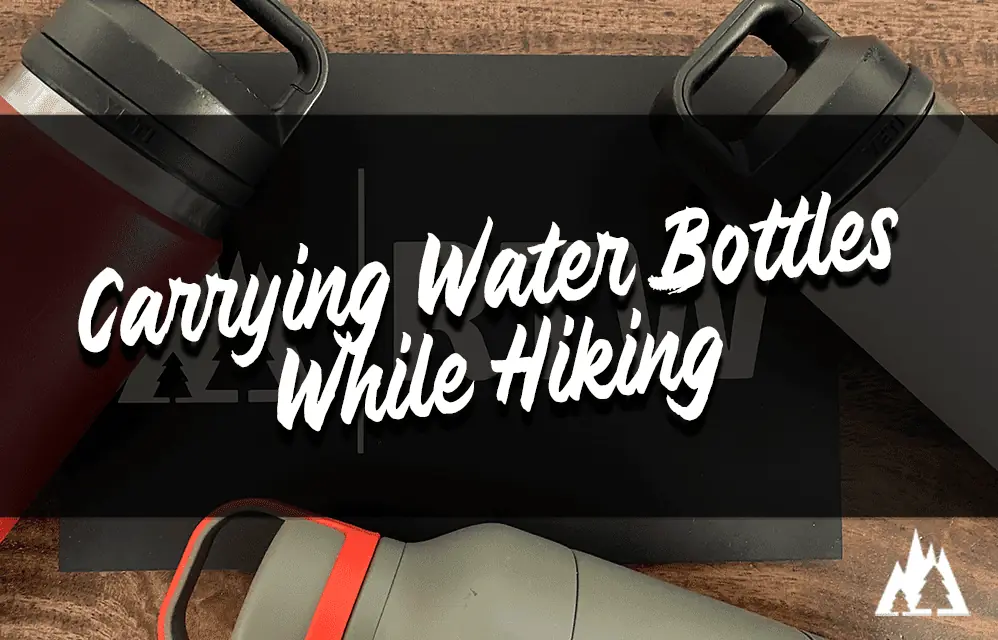
How to carry a water bottle hiking? Ok, hear me out on this.
As straight-forward as this may sound, not too many people think of the implications of carrying a water bottle while hiking.
And from experience, there are better ways to stay hydrated than holding a water bottle.
If you’re not bringing water during your hikes, you should.
And those who do, don’t usually bring enough.
You can carry a water bottle with your hands, throw it in your hiking bag or side pocket, or use a carabiner to latch it on the exterior of your bag on the handle or molle panel strap. Keeping your hands free is recommended when hiking, especially on loose gravel or uneven terrain. This will help gain your balance and provide a way to support yourself if you happen to slip and fall.
Hydration is key when it comes to staying safe and healthy during hikes. I’ll discuss what to look for when selecting one, plus helpful accessories that make transporting your hydration easier.
Let’s dive in.
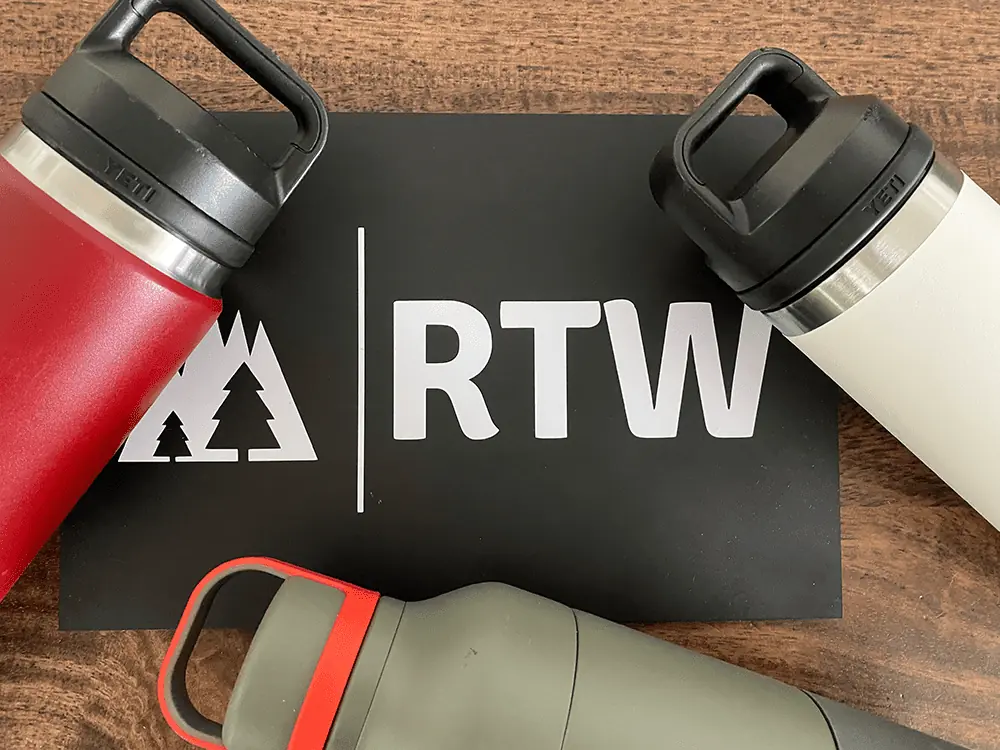
Benefits of Carrying a Water Bottle While Hiking
Carrying a water bottle while hiking is essential to staying hydrated and healthy outdoors.
Some of the core benefits are:
- Aids in hydration
- Eco-friendly
- Weight distribution
Hydration
Staying hydrated is important when hiking by drinking plenty of fluids throughout the day.
But how much?
A good general recommendation is about one half-liter of water per hour of moderate activity in moderate temperatures. You may need to increase how much you drink as the temperature and intensity of the activity rise. For example, strenuous hiking in high heat may require that you drink one liter of water or more per hour. As you gain experience, you’ll be able to fine-tune how much you drink.
REI
Weight Distribution
In addition to keeping yourself properly hydrated, carrying a refillable water bottle can help evenly distribute the weight load between your shoulders when backpacking or traveling long distances with heavy gear.
This helps prevent fatigue and soreness caused by unevenly distributed weight over long periods, making for more comfortable hikes overall.
However, from my experience, having your hands free while hiking is important.
When you’re hiking through un-leveled terrain, maintaining your balance is crucial.
I would rather have you hold a water bottle than not have water at all.
Using reusable bottles is much better for the environment than single-use plastics, as they don’t end up in landfills after just one use like disposable containers does.
They can be used repeatedly until they wear out naturally over time – which usually takes years. Using reusable bottles also reduces our dependence on oil-based plastics, which are linked to numerous environmental issues such as ocean pollution and global warming due to their production process alone (not even considering how much waste these products create).
How to Carry a Water While Hiking
Ah, the meat of the post.
While there are many ways to bring water on your hikes, the best option depends on your needs and preferences. Here’s a look at some of the most popular options:
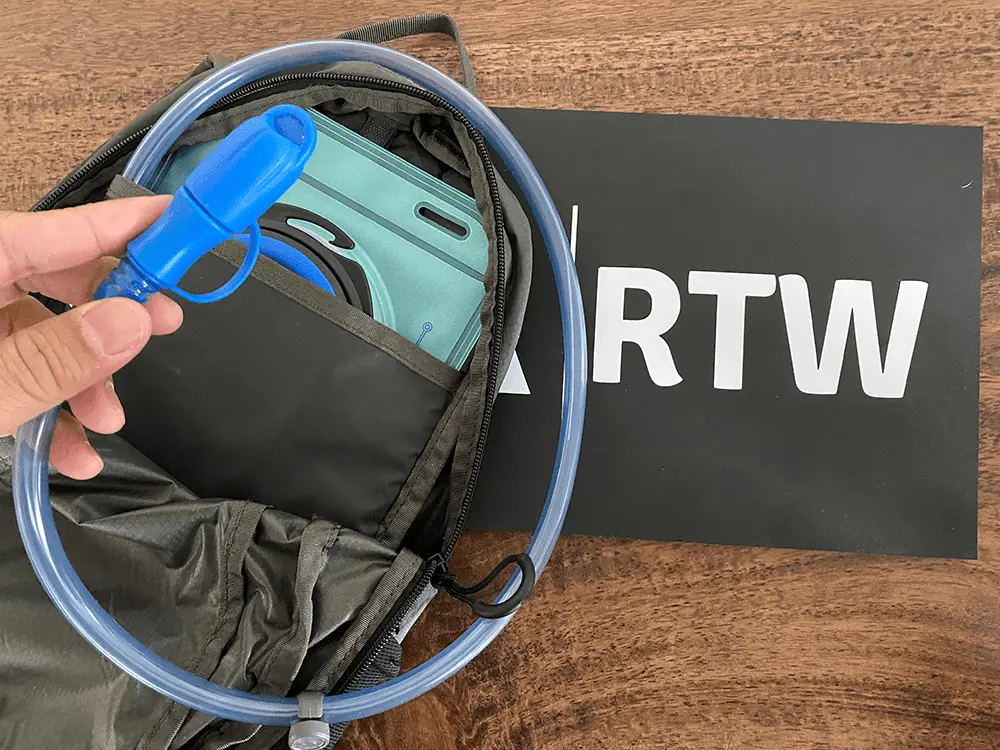
Backpack with Built-in Hydration System
A backpack with a built-in hydration system is one of the most convenient ways to carry your water bottle while hiking.
It typically includes an insulated reservoir that fits into an internal pocket in the pack and tubing that allows you to drink without taking off your pack.
However, due to their added bulk and weight when full, these systems may not be suitable for more strenuous hikes or backpacking trips where weight is a primary concern.
Waist Pack or Fanny Pack with Water Bottle Holder
Waist packs and fanny packs are great for carrying small items like snacks, phones, keys, etc., but they also make good places to store a water bottle if you don’t want it taking up space in your main pack.
Many waist packs come with dedicated pockets or holders specifically designed for carrying water bottles securely against your body while you hike.
Having a water bottle close at hand is convenient, and with a waist pack or fanny pack with an integrated holder, you can access it without having to take off your main backpack.
Shoulder Strap with Water Bottle Holder Attachment
Another way to keep your hands free while still keeping easy access to hydration is by using shoulder straps equipped with specialized holders for attaching water bottles directly onto them. These straps usually have adjustable buckles, so you can adjust how tight or loose they fit around your shoulders depending on how much weight (and sloshing) you want them bearing during activity—a real plus if comfort is important.
Tips for Choosing the Right Water Bottle for Hiking
When it comes to selecting the right water bottle for hiking, size, and capacity are key considerations. A larger bottle will hold more water but may be too bulky or heavy to carry on a long hike.
Conversely, a smaller bottle could prove insufficient for longer hikes.
Finding a balance between these two extremes that fits your needs and preferences is important. Additionally, you should consider how much space is available in your backpack or waist pack before making your selection.
Material is another factor when choosing the best water bottle for hiking.
Plastic containers may be lightweight and more affordable than stainless steel options; however, they can become brittle due to prolonged exposure to heat and sunlight.
Stainless steel bottles are durable but heavier than plastic models; they retain heat better, so warm drinks stay warmer longer during hot days out on the trail.
Collapsible bottles made of silicone or rubberized fabric offer convenience as well as portability since they can be rolled up when empty and take up very little space in your bag or pocket until needed again later on down the road (or trail).
When selecting a water bottle for hikes of varying durations, insulation is an element that must be considered. The longer you plan on being out there, the more important insulation becomes.
Insulated bottles keep liquids cold all day without constantly replenishing with ice cubes from streams along the way like non-insulated varieties require.
Some insulated models even come with vacuum-sealed double walls that help maintain temperature further by preventing outside air from entering through condensation build-up inside them while carrying hot liquids such as coffee or tea.
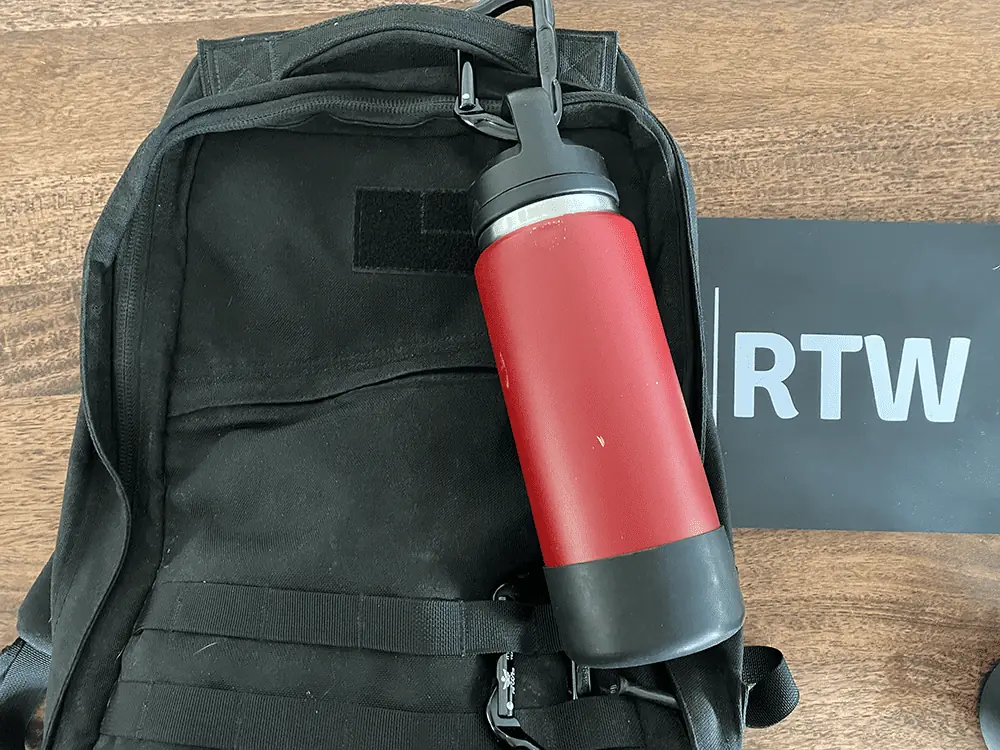
Accessories
For hikers seeking an easier way to carry their water bottles, hands-free hydration systems provide a convenient solution with adjustable bladders that fit inside backpacks and allow for drinking without stopping.
A shoulder strap with an adjustable bladder inside the backpack, allowing you to drink without having to take off your pack, is a great way of hands-free hydration. For those looking to stay hydrated while on the move, various sizes of bladders are available for purchase that can fit in backpacks and be used without pausing. Some even have insulation built into them, which helps keep the water cool during hot days.
Portable Filters and Purifiers
If you’re worried about drinking contaminated or unsafe water while on the trail, portable filters and purifiers are essential for carrying a water bottle while hiking.
Many types are available, ranging from small straws that filter out bacteria and other contaminants to larger gravity filters that attach directly to your bottle. They’re lightweight and easy to use, perfect for long hikes when refilling isn’t always possible or convenient.
Insulated sleeves and covers help keep your water cold in hot weather by providing extra insulation against heat transfer from outside sources like direct sunlight or ambient air temperature.
They also protect against bumps if you drop your bottle accidentally along the trail, which is common when trekking over rocky terrain. Look for insulated sleeves made with neoprene, as they offer superior thermal protection compared to other materials such as nylon or polyester.
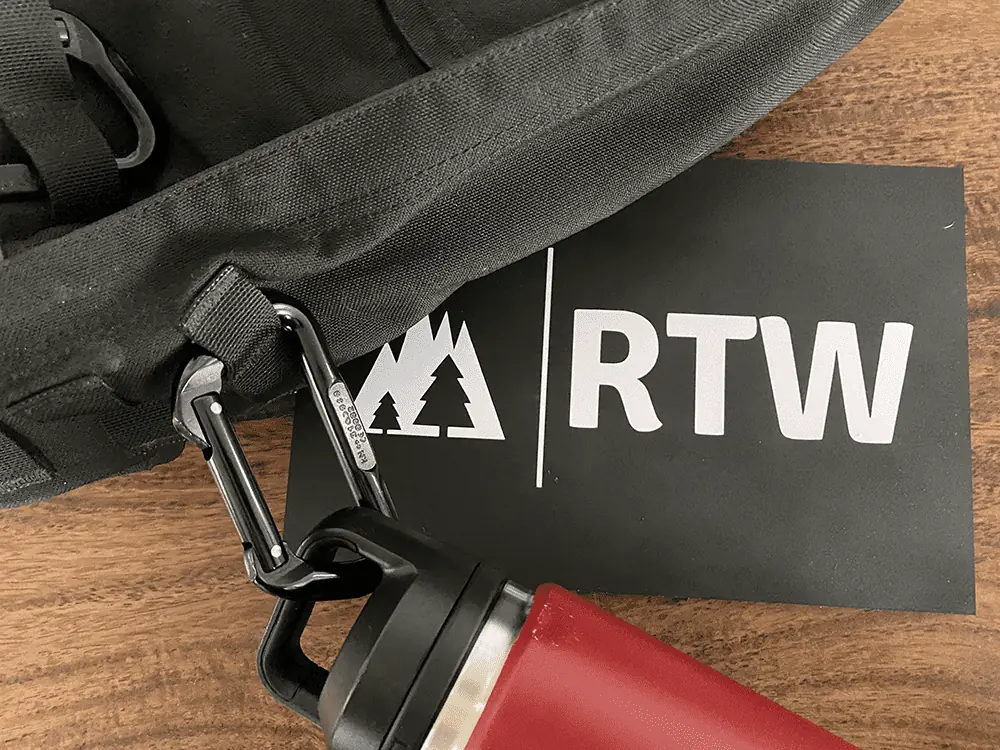
Carabiners
If you have a water bottle with a handle, you can use a carabiner to hook it onto a strap on your backpack when you need your hands free during a hike.
I like to carry a few carabiners in my hiking backpack for that reason. If my bag is full, I’ll hook the carabiner on a molle panel strap on my backpack or on the thin part of my shoulder strap.
FAQs
What do you carry water in when hiking?
Hiking necessitates bringing along a water vessel that is both lightweight and resilient.
A water bottle or hydration bladder are both suitable options for shorter hikes.
A reusable plastic or metal water bottle with an insulated sleeve can help keep your drink cold longer.
If you plan on going on a long hike, investing in a good quality hydration bladder such as those made by Camelbak will be worth the money spent due to their durability and portability.
Additionally, they allow you to easily sip from the tube while walking without stopping and taking out your water bottle each time you need a drink.
What is the most efficient way to carry water?
The most efficient way to carry water depends on the individual and their needs.
For activities such as day hikes or fishing trips, a hydration pack with a capacity for up to two liters is an effective way of carrying water while keeping the weight distributed evenly.
Investing in a good quality water bladder system that includes multiple containers of various sizes for longer treks or camping trips is recommended.
A balanced load on your body can be maintained by having multiple containers with differing capacities, which a water bladder system provides.
Additionally, collapsible plastic bottles are lightweight and easy to transport when empty but can be filled quickly at any source along the trail or campsite.
How do you carry water while traveling?
When traveling outdoors, it is important to stay hydrated. Water can be carried while on the go using a reusable water bottle or canteen, collapsible plastic containers, or other methods.
The most popular option is to use a reusable water bottle or canteen that can be refilled at various sources along your journey. An alternate approach is to bring foldable, plastic receptacles that accommodate larger volumes of liquid and conveniently store them in bags or rucksacks when not needed.
Additionally, some people opt for a hydration bladder with an attached tube, allowing easy access to their beverage without stopping and taking off their backpacks whenever they need a drink.
Ultimately, choosing the right method depends on personal preference and activity level; however, all options will help ensure you have enough H2O throughout your travels.
How do you carry a water bottle pack?
There are a few ways to carry a water bottle pack. The most popular way is using a belt clip or carabiner attached to your belt loop, backpack strap, or other clothing items.
The bottle can be kept secure and easily accessed by attaching it to your clothing. You can also use an adjustable shoulder strap that goes around your torso and attaches with clips at either end for easy carrying on long hikes or trips.
Additionally, some backpacks come equipped with loops specifically designed for holding bottles, so they stay secure during movement. No matter which method you choose, make sure it’s comfortable enough for extended wear without causing any strain on your body.
Before You Go
Before you go make sure you check out these other resources to help you stay hydrated while hiking:






